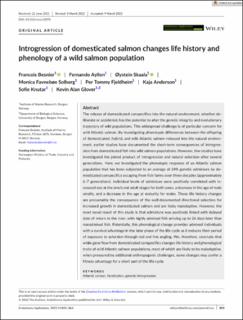Introgression of domesticated salmon changes life history and phenology of a wild salmon population
Besnier, Francois; Ayllon, Fernando; Skaala, Øystein; Solberg, Monica Favnebøe; Fjeldheim, Per Tommy; Andersen, Kaja Christine; Knutar, Sofie; Glover, Kevin Alan
Peer reviewed, Journal article
Published version
Permanent lenke
https://hdl.handle.net/11250/3004537Utgivelsesdato
2022Metadata
Vis full innførselSamlinger
- Articles [3012]
- Publikasjoner fra CRIStin [3070]
Sammendrag
The release of domesticated conspecifics into the natural environment, whether deliberate or accidental, has the potential to alter the genetic integrity and evolutionary trajectory of wild populations. This widespread challenge is of particular concern for wild Atlantic salmon. By investigating phenotypic differences between the offspring of domesticated, hybrid, and wild Atlantic salmon released into the natural environment, earlier studies have documented the short-term consequences of introgression from domesticated fish into wild salmon populations. However, few studies have investigated the joined product of introgression and natural selection after several generations. Here, we investigated the phenotypic response of an Atlantic salmon population that has been subjected to an average of 24% genetic admixture by domesticated conspecifics escaping from fish farms over three decades (approximately 6–7 generations). Individual levels of admixture were positively correlated with increased size at the smolt and adult stages for both sexes, a decrease in the age of male smolts, and a decrease in the age at maturity for males. These life history changes are presumably the consequence of the well-documented directional selection for increased growth in domesticated salmon and are likely maladaptive. However, the most novel result of this study is that admixture was positively linked with delayed date of return to the river, with highly admixed fish arriving up to 26 days later than nonadmixed fish. Potentially, this phenological change provides admixed individuals with a survival advantage in the later phase of the life cycle as it reduces their period of exposure to selection through rod and line angling. We, therefore, conclude that while gene flow from domesticated conspecifics changes life history and phenological traits of wild Atlantic salmon populations, most of which are likely to be maladaptive, when pressured by additional anthropogenic challenges, some changes may confer a fitness advantage for a short part of the life cycle.
